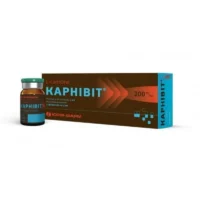Description
Ergocalciferol Oral Solution 1.25 mg/ml. 10 ml. №1 Vial
Ingredients:
Ergocalciferol (Vitamin D2), propylene glycol, ethanol, and water.
Mechanism of Action:
Ergocalciferol, a synthetic form of Vitamin D2, is essential for maintaining calcium and phosphorus balance in the body.
Pharmacological Properties:
Ergocalciferol acts by promoting the absorption of calcium and phosphorus in the intestines and aiding in their utilization for bone health and other physiological processes.
Indications for Use:
This oral solution is indicated for the treatment of Vitamin D deficiency in adults, where supplementation is necessary to restore adequate levels of Vitamin D in the body.
Contraindications:
Avoid using this product in cases of hypercalcemia, hypervitaminosis D, or hypersensitivity to any component of the formulation to prevent adverse reactions.
Side Effects:
Common side effects may include gastrointestinal disturbances, allergic reactions, and rarely, symptoms of Vitamin D toxicity such as hypercalcemia.
Usage Instructions:
Prior to administration, ensure thorough shaking of the solution. The typical adult dosage is 1.25 mg (50,000 international units) once weekly, as prescribed by a healthcare professional. It can be taken orally, with or without food, following the provider’s guidance.
Benefits Compared to Analogues:
Ergocalciferol offers a reliable and effective means of treating Vitamin D deficiency with established pharmacological actions and a well-documented safety profile compared to other Vitamin D supplements.
Suitable Patient Groups:
This product is suitable for adults requiring Vitamin D supplementation to address deficiency-related conditions. Special caution and dosage adjustments may be necessary for pediatric and geriatric populations.
Storage and Shelf Life:
Keep the product tightly sealed in its original packaging, away from light and moisture, at room temperature. Adhere to the expiration date mentioned on the label to ensure potency and efficacy.
Packaging Description:
The product is available in a 10 ml vial, providing a convenient and accurate dosage for administration.
Scientific Evidence:
Ergocalciferol has demonstrated efficacy in numerous studies for treating Vitamin D deficiency and its associated complications. Adequate Vitamin D levels are crucial for bone health, immune function, and overall well-being.
Additional Information:
Regular monitoring of serum calcium levels is advised during ergocalciferol therapy to prevent the risk of hypercalcemia. Consult your healthcare provider regarding any concerns or potential drug interactions.





